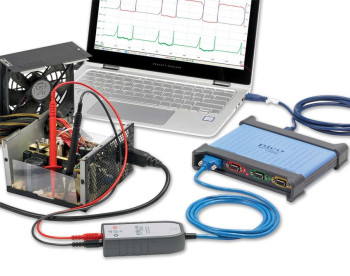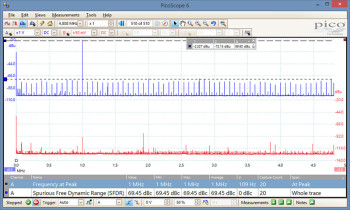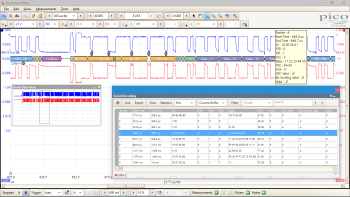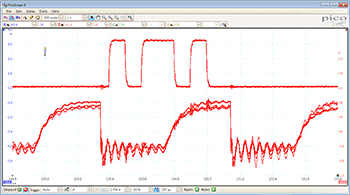PicoScope 4444 differential oscilloscope features

PicoConnect 441 probes are ideal for work with low voltage SMPS, PicoConnect 442 (shown) for voltages up to 1000 V.
True differential measurements in high resolution
The PicoScope 4444’s four inputs allow you to make true differential measurements. The maximum input range at full scale is ±50 V (±1000 V CAT III using the PicoConnect 442 probe), and the maximum common-mode range is also ±50 V (also ±1000 V with the PicoConnect 442 probe). You can set the scope to measure at resolutions of 12 or 14 bits, far better than the 8-bit resolution typical of many oscilloscopes. The deep capture memory (up to 256 million samples shared by the active channels) is another advantage, allowing you to carry out long captures without lowering the sampling rate.

FFT spectrum analyzer
The spectrum view plots amplitude against frequency and is ideal for finding noise, crosstalk or distortion in signals. The spectrum analyzer in PicoScope is of the Fast Fourier Transform (FFT) type which, unlike a traditional swept spectrum analyzer, can display the spectrum of a single, non-repeating waveform.
A full range of settings gives you control over the number of spectrum bands (FFT bins), window types, scaling (including log/log) and display modes (instantaneous, average, or peak-hold).
You can display multiple spectrum views alongside oscilloscope views of the same data. A comprehensive set of automatic frequency-domain measurements can be added to the display, including THD, THD+N, SNR, SINAD and IMD. A mask limit test can be applied to a spectrum and you can even use the AWG and spectrum mode together to perform swept scalar network analysis.
More information on Spectrum analyzer >>

Noise that is invisible at 8 bits (black trace) is revealed at 12 bits
High resolution offers 64x more detail
The PicoScope 4444 can sample at speeds of up to 400 MS/s with 12-bit high resolution. This is 16 times more vertical resolution than traditional 8-bit oscilloscopes (4096 vertical levels vs 256). The example shows how with a 12-bit oscilloscope (blue trace) you can zoom in to reveal details of the signal that are not visible on an 8-bit oscilloscope (black trace).
The PicoScope 4444 hardware can also be switched into a 14-bit mode (maximum sampling rate drops to 50 MS/s) offering 64 times more vertical resolution than traditional 8-bit oscilloscopes. The ADC in this mode is a 14-bit flash converter, giving you the ability to capture extremely fine details in scientific and battery test applications.
Once you have seen high-resolution waveforms on a high-resolution PC monitor you will never want to use a traditional benchtop oscilloscope with its small display again.
As well as improved oscilloscope traces, high resolution offers big benefits when performing spectrum analysis, offering an additional 20 dB dynamic range on the spectrum over 8-bit oscilloscopes. Signals that were previously hidden in the noise floor are now clearly visible and the spectrum becomes a powerful tool to track down the causes of noise.

Deep memory oscilloscopes are ideal for serial decoding
Deep-memory oscilloscopes
The PicoScope 4444 oscilloscope has a huge buffer memory of 256 million samples – many times larger than competing scopes of either PC-based or traditional benchtop design.
Deep memory produces several benefits: fast sampling at long timebases, timebase zoom, and memory segmentation to let you capture a sequence of events. Deep memory oscilloscopes are also ideal for serial decoding applications as they allow the capture of many thousands of frames of data.
Most other scopes with large buffers slow down when using deep memory, so you have to manually adjust the buffer size to suit each application. You don’t have to worry about this with PicoScope deep-memory scopes as hardware acceleration ensures you can always use deep memory while displaying at full speed.
More information on Deep memory oscilloscopes >>

DeepMeasure parameters
DeepMeasureTM
One waveform, millions of measurements.
Measurement of waveform pulses and cycles is key to verification of the performance of electrical and electronic devices.
DeepMeasure delivers automatic measurements of important waveform parameters on up to a million waveform cycles with each triggered acquisition. Results can be easily sorted, analyzed and correlated with the waveform display.
More information on DeepMeasure >>

Digital triggering
The majority of digital oscilloscopes still use an analog triggering architecture based on comparators. This causes time and amplitude errors that cannot always be calibrated out and often limits the trigger sensitivity at high bandwidths.
In 1991 Pico pioneered the use of fully digital triggering using the actual digitized data. This technique reduces trigger errors and allows our oscilloscopes to trigger on the smallest signals, even at the full bandwidth. Trigger levels and hysteresis can be set with high precision and resolution.
The reduced rearm delay provided by digital triggering, together with segmented memory, allows the capture of events that happen in rapid sequence. On many of our products, rapid triggering can capture a new waveform every microsecond until the buffer is full.
More information on Advanced digital triggers >>

Hardware acceleration ensures fast screen update rates even when collecting 10,000,000 samples per waveform
Hardware Acceleration Engine (HAL3)
Some oscilloscopes struggle when you enable deep memory; the screen update rate slows and controls become unresponsive. The PicoScope 4444 avoids this limitation with use of a dedicated hardware acceleration engine inside the oscilloscope. Its parallel design effectively creates the waveform image to be displayed on the PC screen. PicoScope oscilloscopes manage deep memory better than competing oscilloscopes, both PC-based and benchtop.
The PicoScope 4444 is fitted with third-generation hardware acceleration (HAL3). This speeds up areas of oscilloscope operation such as allowing waveform update rates in excess of 100 000 waveforms per second and the segmented memory/rapid trigger modes. The hardware acceleration engine ensures that any concerns about the USB connection or PC processor performance being a bottleneck are eliminated.

100 000 waveforms per second
An important specification to understand when evaluating oscilloscope performance is the waveform update rate, which is expressed as waveforms per second. While the sample rate indicates how frequently the oscilloscope samples the input signal within one waveform, or cycle, the waveform capture rate refers to how quickly an oscilloscope acquires waveforms.
Oscilloscopes with high waveform capture rates provide better visual insight into signal behavior and dramatically increase the probability that the oscilloscope will quickly capture transient anomalies such as jitter, runt pulses and glitches – that you may not even know exist.
The PicoScope 4444 oscilloscope uses hardware acceleration to achieve up to 100 000 waveforms per second.
More information on Fast waveform update rates >>

Signal integrity
Most oscilloscopes are built down to a price. PicoScopes are built up to a specification.
Careful front-end design and shielding reduces noise, crosstalk and harmonic distortion. Years of oscilloscope design experience can be seen in improved bandwidth flatness and low distortion.
We are proud of the dynamic performance of our products and publish our specifications in detail. The result is simple: when you probe a circuit, you can trust in the waveform you see on the screen.
PicoScope = PC oscilloscopes done properly.